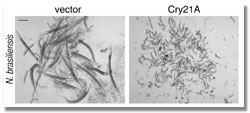 |
|
|
 |
||
|
||||||||||||||
|
With Toxic Crystals, Bacterium Targets - and Takes out - Nematodes
|
|
|
|
ARLINGTON, Va. -- Roundworms, hookworms, watch out. Scientists this week announced that a soil bacterium's crystal proteins, long an effective weapon against many insect pests, are toxic to some nematodes, too.
The crystal proteins - created by some strains of Bacillus thuringiensis, more commonly known as Bt - thwart the development of some nematodes and kill others outright. The findings raise the possibility that these proteins might one day be used to combat parasitic worms that infect nearly one-fourth of the world's human population. Nematodes - unsegmented, long, round worms pointed at both ends - are responsible for illnesses that can lead to elephantiasis of the limbs, intestinal lesions, a type of meningitis and "river blindness."
Led by biologist Raffi V. Aroian of the University of California-San Diego, a team of researchers examined the impact of seven different Bt toxins upon six different nematode species, including one intestinal parasite. Funded by the National Science Foundation (NSF), the research appears in the March 4 journal Proceedings of the National Academy of Sciences (PNAS) and is available in the journal's online "early edition" at www.pnas.org.
The crystals, of which there are many variations, form from the aggregation of proteins that are produced as the bacillus makes spores. Individually, their toxicity is very species-specific, and more than 150 insect species are known to be susceptible to one type of Bt crystal or another. However, the crystals are harmless to humans and to natural enemies of many crop pests.
(For more about Bacillus thuringiensis, visit the Aroian lab's web site at www.btcrystal.org.)
Nematodes, relatively simple anatomically and genetically, are found in nearly every environment. Among the more than 100,000 known species are plant parasites, such as roundworms; animal parasites, such as hookworms and heartworms; and insect pathogens. Most are shorter than short-grained rice. Some, particularly those found in the relative comfort of another organism's gut, can reach lengths of several meters, including one in sperm whales that measures upwards of 13 meters long. Many feed on bacteria.
Applying an array of crystal proteins from Bt to a diverse group of five small, free-living nematodes, Aroian's group found that each worm species tested was susceptible to at least one of the toxins. The scientists also found that three of the Bt crystals were effective in crippling the free-living stage of a worm (Nippostrongylus brasiliensis) that spends its parasitic days in rats' guts.
Represented in the study were two "largely unstudied classes of crystal proteins," one of which is closely related to those long in use as organic insecticides. Their effectiveness known for nearly a century and first approved for use in the United States in 1961, these Bt insecticides kill crop-killing caterpillars and beetles, and disease-transmitting black flies and mosquitoes.
According to the PNAS report, "The success of these toxins is due in large part to their high toxicity towards insects but no/low toxicity toward other animals. They have an excellent track record in over 50 years of use by organic and conventional farmers."
The researchers found that the Bt crystal proteins' "toxicity in nematodes correlates with damage to the intestine, consistent with the mechanism of crystal toxin action in insects," leading them to question whether the worms, not insects, may be the natural primary target of the soil-dwelling bacterium's toxin.
"It is puzzling why a bacterium that is so ubiquitously found in the soil might have evolved ingestible toxins to target insects that may spend little time feeding in the soil," they write. "On the other hand, there are estimated to be more than 100,000 species of nematodes, many of which live in the soil and ingest bacteria. Could nematodes be a prime target for Bt and its crystal proteins?"
According to Rita Teutonica, a genetics program director at NSF, "This report complements Aroian's current exploration into the genetics of resistance to Bt toxins in the nematode Caenorhabditis elegans (a widely used model organism for research). More broadly, it also illustrates how inquiries into basic genetic mechanisms may ultimately lead to answers with profound worldwide benefits."
NSF is an independent federal agency that supports fundamental research and education across all fields of science and engineering, with an annual budget of nearly $5 billion. NSF funds reach all 50 states through grants to nearly 2,000 universities and institutions. Each year, NSF receives about 30,000 competitive requests for funding, and makes about 10,000 new funding awards. NSF also awards over $200 million in professional and service contracts yearly.
Receive official NSF news electronically through the e-mail delivery system, NSFnews. To subscribe, send an e-mail message to join-nsfnews@lists.nsf.gov. In the body of the message, type "subscribe nsfnews" and then type your name. (Ex.: "subscribe nsfnews John Smith")
Useful Web Sites:
NSF Home Page: http://www.nsf.gov
News Highlights: http://www.nsf.gov/home/news.html
Newsroom: http://www.nsf.gov/od/lpa/news/media/start.htm
Science Statistics: http://www.nsf.gov/sbe/srs/stats.htm
Awards Searches: http://www.fastlane.nsf.gov/a6/A6Start.htm
|
|
